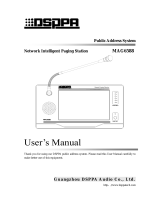
i
Operations Guide 931156I CyberData Corporation
Contents
Chapter 1 Product Overview 1
1.1 How to Identify This Product .....................................................................................................1
1.2 Typical System Installation .......................................................................................................2
1.3 Features ...................................................................................................................................3
1.4 Supported Protocols .................................................................................................................4
1.5 Supported SIP Servers .............................................................................................................4
1.6 Specifications ...........................................................................................................................5
1.7 Typical Coverage ......................................................................................................................6
1.7.1 Intelligibility Outdoor Field Test .......................................................................................6
1.7.2 Typical Warehouse Paging Setup ...................................................................................7
1.8 Compliance ..............................................................................................................................8
1.8.1 CE Testing ......................................................................................................................8
1.8.2 FCC Statement ..............................................................................................................8
Chapter 2 Installing the SIP Paging Amplifier 9
2.1 Parts List ..................................................................................................................................9
2.2 SIP Paging Amplifier Setup ....................................................................................................10
2.2.1 SIP Paging Amplifier Components ...............................................................................11
2.2.2 Connecting the SIP Paging Amplifier ..........................................................................12
2.2.3 SIP Paging Amplifier System Installation and Connection Options ..............................15
2.2.4 Strobe Connections Behind the Port Cover .................................................................17
2.2.5 Connecting the Strobe .................................................................................................18
2.2.6 SIP Paging Amplifier Jumpers ......................................................................................19
2.2.7 Ethernet Connection ....................................................................................................19
2.2.8 Loudspeaker Type ........................................................................................................20
2.2.9 Cabling/Wiring ..............................................................................................................20
2.2.10 Confirm Operation ......................................................................................................21
2.2.11 Confirm the IP Address and Test the Audio ...............................................................22
2.2.12 Adjust the Volume ......................................................................................................23
2.3.1 Factory Default Settings ...............................................................................................26
2.3.2 SIP Paging Amplifier Web Page Navigation .................................................................27
2.3.3 Using the Toggle Help Button .......................................................................................28
2.3.4 Log in to the Home Page ..............................................................................................30
2.3.5 Configure the Device ....................................................................................................34
2.3.6 Configure the Network Parameters .............................................................................41
2.3.7 Configure the SIP (Session Initiation Protocol) Parameters .........................................44
2.3.8 Configure the Multicast Parameters .............................................................................53
2.3.9 Configure the Sensor Page Parameters .......................................................................57
2.3.10 Configure the Audiofiles Page Parameters .................................................................61
2.3.11 Configure the Events Parameters ..............................................................................68
2.3.12 Configure the Autoprovisioning Parameters ...............................................................74
2.4.1 Downloading the Firmware ...........................................................................................86
2.4.2 Reboot the Device ........................................................................................................88
2.5.1 Command Interface Post Commands ..........................................................................89
Appendix A Mounting the Amplifier 94
A.1 Mount the Amplifier ...............................................................................................................94
A.2 Dimensions ............................................................................................................................95
Appendix B Setting up a TFTP Server 96
B.1 Set up a TFTP Server ............................................................................................................96
2.1.1 In a LINUX Environment ...............................................................................................96
2.1.2 In a Windows Environment ..........................................................................................96
Appendix C Troubleshooting/Technical Support 97
C.1 Frequently Asked Questions (FAQ) ........................................................................................97
C.2 Documentation .......................................................................................................................97

























